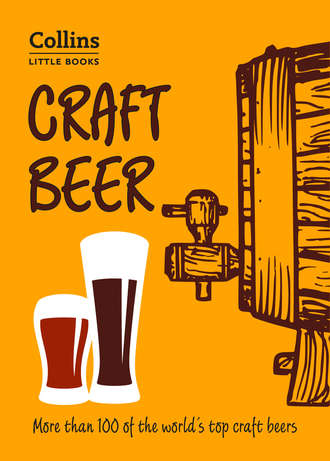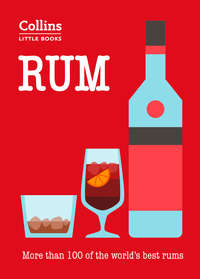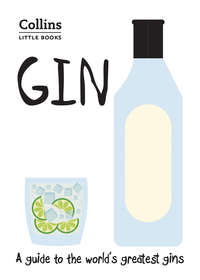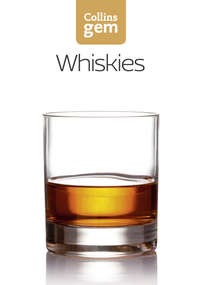
Полная версия
Craft Beer: More than 100 of the world’s top craft beers


Copyright
HarperCollins Publishers
Westerhill Road
Bishopbriggs
Glasgow
G64 2QT
First Edition 2018
© HarperCollins Publishers 2018
Ebook Edition © February 2018 ISBN: 9780008271213
Version: 2018-03-01
Collins® is a registered trademark of HarperCollins Publishers Limited
www.collins.co.uk
A catalogue record for this book is available from the British Library
Author: Dominic Roskrow
All rights reserved under International and Pan-American Copyright Conventions. By payment of the required fees, you have been granted the nonexclusive, nontransferable right to access and read the text of this e-book on-screen. No part of this text may be reproduced, transmitted, downloaded, decompiled, reverse-engineered, or stored in or introduced into any information storage and retrieval system, in any form or by any means, whether electronic or mechanical, now known or hereafter invented, without the express written permission of HarperCollins e-books.
HarperCollins does not warrant that www.collins.co.uk or any other website mentioned in this title will be provided uninterrupted, that any website will be error-free, that defects will be corrected, or that the website or the server that makes it available are free of viruses or bugs. For full terms and conditions please refer to the site terms provided on the website.
HarperCollinsPublishers has made every reasonable effort to ensure that any picture content and written content in this ebook has been included or removed in accordance with the contractual and technological constraints in operation at the time of publication.
Contents
Cover
Title Page
Copyright
Talking about a revolution
What is a craft beer?
Beer styles
A – Z of craft beers
3 Monts
Abominable Winter Ale
Amarillo Sour
Anchor Porter
Anosteké
Audit Ale
Axe Edge
Backyard Lazy Daze
Bam Noire
Battledown Original
Bede’s Chalice
Beyond Modus IV
Bitter & Twisted
Black Bishop
Black Grouse
Bling Bling
Bluebird Premium XB
Boundary Export Stout
Bracia
Broken Dream
Brooklyn Lager
Brugse Zot Blond
Buxton Anglo-Belgique
Calypso
Caribbean Chocolate Cake
Casey Saison
Celis White
Clogwyn Gold
Coolship Cerise
Crafty Dan 13 Guns
Cross Bones
Cuvee de Tomme
De Ranke XXX-Bitter
Dead Pony Club
Dennis Hopp’r
Ein Stein
Engine Vein
Ensorcelled
Falkon Kamsot
Farmer’s Reserve Blueberry
Farmhouse Red
First World Problems
FMB 101
Foundation 11
Fraoch Ale
Freedom Amber Rye
Friday
Funk
Gadds’ No 3
Gentleman’s Wit
Ghost Ship
Ginormous
Gonzo Imperial Porter
Goose IPA
Green Devil
Gueuze Tilquin à l’Ancienne
Guldenberg
Gunnamatta Earl Grey IPA
Halcyon
Hardknott Azimuth
Headless
Heart & Soul
Hibernation
Hof ten Dormaal Saison
Hop Gun
Hop Hog
Hopfenstopfer Citra Ale
Howling Pils
Imperial Extra Double Stout
Jaipur
Jambe-de-Bois
Jambo!
Kaleidoscope
Kasteel Rouge
Keller Pils
Kernel Pale Ale
Kingpin
Kiwanda
Kiwi Rising
Kuehnes Blonde
La Corne du Bois des Pendus Tripel
Lazy Haze
Mariana Trench
Midnight Sun
Mont des Cats Bière Trappiste
Mr Trotter’s Chestnut Ale
Noblesse VSOP
Old Freddy Walker
Passion Drop
Peanut Butter Milk Stout
Peppercorn Saison
Polygraph
Proper Job
Punk IPA
Quartz Heart
Quintet
Radical Road
Red Sky
Rhetoric Edition 4.1
Rübaeus
Saison à la Provision
Salty Kiss Gooseberry Gose
Shape Shifter
Siberia Rhubarb Saison
Single Hop Kohatu Mango Femme Fatale
Sour Grapes
Sourdough
Stateside Saison
Sun Dazed
Sunday
Tempest Harvest
Three Grain Belgian Blonde
Ticketybrew Dubbel
Tournay Noire
Twilight of the Idols
Urban Fox
Whitewalker
Wolf
Worker’s Comp
Wu Gang Chops the Tree
Index
Picture Credits
About the Author
About the Publisher
Talking about a revolution
Take a look at today’s craft brewing industry and it’s hard to believe that as recently as the turn of the millennium the perception of beer brewing was of scruffy, hippy types in sandals, geekily discussing secondary fermentations.
Back then it was all about real ale in the United Kingdom, and about proper beer in America. To outsiders the battle for beer was just that – a campaign against mass produced and homogenous beer, and especially lager. Unless it was a lager produced in Continental Europe. Or in a garage in Portland, Oregon.
The problem was that some of the alternatives weren’t particularly appealing. Flat, scuzzy, cloudy concoctions might have been considered real by the diehards, but for many of the rest of us, they were just really bad.
Around that time, though, something changed. And when it did, it changed fast.
As Editor of Beers of the World, I remember sitting one Saturday evening sipping a new American craft beer – something from Rogue if I remember correctly – waiting to be interviewed on an American radio programme about beer. I could hear the two hosts on the show chatting about some new ale or other, and I recall being amazed by their passion and enthusiasm, and their knowledge of their subject. It was unnerving.
And that sort of passion flowed through the United States from Alaska to the Alamo as craft brewing took hold, as scores of enthusiasts turned their home brewing hobby into a business. Some brewers set out modestly and chose to stay that way.
Some started small but evolved into substantial businesses, moving to ever more sizeable premises and creating new jobs as they went. Some had grandiose aspirations from the outset, and are now living their dream.
Perhaps inevitably the United Kingdom would follow. All the pieces were in place due to years of work by the Campaign for Real Ale and organisations such as the Small Independent Brewers’ Association (SIBA), which has now morphed into the Society of Independent Brewers, and the Independent Family Brewers of Britain (IFBB). Regional brewers were becoming more adventurous as they sought to create a niche for their beers among the plethora of brands marketed by big producers. Outstanding beer writers and a new generation of bloggers were writing about craft beer to a curious and broadminded beer community. Home brewing has long been popular in Britain, and some home brewers had become very good at it. Beer tourism to Belgium, The Netherlands and France had grown in popularity, and regional and small brewers were thriving due to favourable tax breaks.
When the phenomenon swept through Britain, the new producers carried with them many traditional European breweries with histories going back centuries, paying tribute to them, trying to reproduce their specific styles of beer, and resurrecting old redundant recipes.
Today’s craft brewers come in all shapes and sizes. Of course the usual suspects are in the mix, and there are countless stories of beer-loving friends turning long-held dreams of making exciting beers into reality. But there are less obvious candidates, too: solicitors and accountants who have turned their backs on the hustle and bustle of city life to embrace something altogether more sedate and satisfying; farmers who have turned a spare outbuilding into a brewery; restaurateurs and pub licensees keen to offer customers a home produced beer.
But while the supply of new beers was dramatic and impressive, what turned microbrewing into a phenomenon was the seemingly endless supply of keen consumers who were ready and willing to explore tastes and styles. Well travelled and familiar with exotic food and drink abroad, a new generation of drinkers was turning its back on homogenous and globalised products and was starting to seek out drinks with heritage, history and provenance.
There are other factors, too. The new drinkers are a health-conscious bunch, and prefer quality over quantity. But conversely, that also means that they’re more open to sipping one or two pints of stronger alcohol, or drinking smaller 33cl or 25cl measures from a bottle of beer with a high alcohol content, rather than traditional session pints from the tap. Many of them are keen to seek out something new and exciting rather than drink what their parents drank. Many understand that there are craft beer styles that have little in common with traditional bitter or lager, and they not only don’t care, they positively welcome the challenge such beers offer them. Many are eager to learn about them and explore further.
All of this was fuelled by the arrival of the Internet. It allowed small businesses to compete with large ones without the need for big advertising budgets, and to find a ready audience for their creative ideas. Enthusiasts are able to use social media and online blogs to draw attention to their discoveries. The Internet has become an educational tool, helping beer lovers understand more about even the most obscure porters, pale ales or sour beers.
Microbrewing has changed the face of our pubs and bars. The colourful chalkboard, with its zany names, varying ABVs, and brief taste descriptors, has become an increasingly visible road map for scores of patrons who see every trip into a licensed premises as a personal adventure and a journey of discovery. Leading supermarkets have shelves stacked with attractive bottles and, increasingly, cans. Upmarket supermarket chain Waitrose now sells single bottles of craft lagers that cost more than a bottle of wine.
They say what goes up must come down, and there are plenty of people who have predicted that the craft industry can’t defy gravity indefinitely, and that an overcrowded marketplace will inevitably mean that some brewers will crash and burn.
By 2018 there were signs that in America at least, the number of new brewers was peaking, and some are starting to fall away. Inevitably, beer drinkers will separate the wheat from the chaff, and poorer products will not survive. But our palates have been changed forever; we have higher expectations of what beer can and should be, and the days of lifetime loyalty to one or two brands are long gone. If you have any doubts that craft brewing is a fad that will fade and die, then take a long, hard look at what even the most tame outlets are now offering, and at the way the global giants are trying to jump on the microbrewing bandwagon.
Never has it been a more exciting time for beer drinkers.
Cheers – don’t mind if I do.
What is a craft beer?
In late 2017 American organisation the Brewers Association (BA), publishers of craftbeer.com, launched a campaign to crowdfund the purchase of Anheuser-Busch, the makers of Budweiser.
The BA needs to raise a highly improbable – bordering on impossible – $213 billion, and while the campaign, called Take Craft Back, has its tongue firmly in its cheek, the underlying message is a very serious one: craft beer is under threat from global corporations intent on tapping into the large pool of beer drinkers, while stepping on anyone who gets in their way.
By the end of 2017 Anheuser-Busch had bought six craft brewers and was making inroads into major distribution channels. Other international drinks companies have also acquired craft breweries. Their beers are presented as if they are still made in a small farm shed in Michigan, but they are a con. Often they taste nothing like the original version – and this is not a good thing.
So what exactly constitutes a craft or microbrewer? This is not an easy question to answer.
The standard dictionary definition of craft is ‘a skill, particularly in a trade’. This definition works for craft brewing, but it begs the question: isn’t all beermaking a craft under this definition?
Wikipedia defines a microbrewery or craft brewery as ‘one that produces small amounts of beer, typically much smaller than large-scale corporate breweries, and is independently owned. Such breweries are generally characterised by their emphasis on quality, flavour and brewing technique.’
This definition is grossly inadequate and incomplete; the last part is based on subjective evaluation, and there can be no place for that in a watertight definition. And what constitutes small? An American brewer and a British brewer may have very different ideas of what the word means, and one person’s shed may be another’s mansion.
More importantly, if a brewery grows due to consumer demand, but continues to make beer the same way but just on a bigger scale, does it then cease to be a craft brewery? And at what size does this happen?
So size can’t be at the core of our definition of what craft brewing is. And although the word ‘craft’ implies an aspect of quality, our definition can’t be totally about quality either. Big doesn’t necessarily mean bad, as fans of Marston’s Pedigree or Guinness will attest. Conversely, it’s highly unlikely that the retired New York stockbroker brewing his first golden ale will hit on the perfect beer at his first attempt. He will almost certainly not make anything nearly as good as the makers of Adnams, Speckled Hen and many other great beers, perfected by skilled craftsmen over generations.
Wikipedia also has a definition for a microdistillery, ‘… a small, often boutique-style, distillery established to produce beverage grade spirit alcohol in relatively small quantities.’
This is more helpful, because of the word ‘boutique’, which can be used to mean ‘a business serving a sophisticated or specialised clientele’.
This is much better. The definition nods toward the concept of size but makes it an issue of demand as well as supply. The word ‘business’ implies a level of care and professionalism, and by using the words ‘sophisticated and specialised clientele’ some concept of quality is brought into the frame. Not only that, but there is a strong implication that if there was a surge in demand from that sophisticated and specialised clientele, the business would still be a boutique one, even if it correspondingly grew to serve the increased demand.
This works for a definition of craft or microbrewing, too. If someone produces a beer that becomes popular so that the business has to grow to meet demand then, under our definition, this remains a craft operation, providing no compromise is made on the quality of their product, and there is no sell-out of the producer’s original aspirations or ideals.
Perhaps, then, a craft brewery can be defined as ‘any brewery that starts out as an independent boutique operation with the intention of making a bespoke and individual beer, and which stays true to the ideals of creating premium and quality beers no matter what happens to it.’
Under this definition it does not matter whether you’re brewing in a traditional way or attempting something innovative. Nor whether you’re brewing by hand on ancient equipment or have a state-of-the-art microbrewery. And it doesn’t matter what ingredients you decide to use as long as the purpose is to enhance and enrich your beer, and not to save money or cut corners.
Glance at many of the websites of the craft brewers featured in this book and they will have a statement about what they set out to achieve with their beers, or they describe how they came into being. In all cases they would fit the definition above. Anheuser-Busch clearly does not.
Beer styles
Alt: A German-style brown ale. Alt translates as ‘old’ in German, and traditionally Altbiers are conditioned for longer than normal.
Belgian ale: Ales under approximately 7.0% ABV that do not fit other categories. Colour ranges from golden to deep amber.
Belgian blonde: Typically fruity, moderately malty, sweet, quite spicy, easy-drinking, copper-coloured ale.
Belgian strong pale ale: Treat with caution, due to high alcohol content. Expect a complex and powerful ale, yet delicate with rounded flavours.
Berliner weisse: a top-fermented, bottle-conditioned wheat beer. The taste is refreshing, tart, sour and acidic, with a lemony-citric fruit sharpness.
Bière de garde: From Northern France. Golden to deep copper or light brown in colour and characterised by a toasted malt aroma, slight malt sweetness in flavour, and medium hop bitterness.
Bitter: A gold to copper colour, with a biscuity malt and hoppy flavour, and medium to high bitterness.
Brown ale: Colour ranges from reddish-brown to dark brown. Beers termed brown ale include sweet low-alcohol beers, medium strength amber beers of moderate bitterness and malty but hoppy beers.
Dubbel: A rich malty beer with some spicy phenolic nuttiness. Mild hop bitterness with no lingering hop flavours.
Dunkel: Traditionally from Bavaria. Smooth, full-bodied, rich and complex, but without being heady or heavy. They boast brilliant ruby hues from the large amount of Munich malts used.
Farmhouse ale: Another name for Saison beers.
Golden ale: Pale, well-hopped and quenching beer developed in the 1980s. Strengths range from 3.5% to 5.3%.
Gose: An unfiltered wheat beer made with 50–60% malted wheat, which creates a cloudy yellow colour and provides a refreshing crispness and a touch of brine.
Gueuze: A traditional Belgian blend of young and old lambics, which are then blended, bottled and aged for two to three years to produce a drier, fruitier and more intense style of lambic.
Hefeweisse: German style of wheat beer made with a typical ratio of 50:50, or even higher, wheat. Has flavours of banana and cloves with an often dry and tart edge, some spiciness, bubblegum or notes of apples.
Imperial stout: Imperial stouts are usually extremely dark brown to black in colour and are intensely malty, deeply roasted and sometimes with accents of dark fruit and chocolate. Imperial stouts are strong and generally exceed 8.0% ABV.
IPA – India Pale Ale: The darling of craft brewing. It is stronger and more bitter than standard pale ale – and was pioneered in England in the early 19th century. There are worldwide varieties. The American version is bigger and bolder with grapefruit, pine, and citrus flavours.
Kölsch – from Köln: Light, delicate top-fermented beer with a dry finish.
Lambic: Naturally fermented with wild yeasts. Dry, sour and acidic, it’s very much a specialist taste, and has grapefruit-like fruitiness. Closer in character to cider or fino sherry.
Old ale: Dark and malty and often of a higher alcoholic strength.
Pale ale: Hoppy and malty flavour and a golden to amber colour. British pale ales can be quite bitter; American-style pale ales have more citrus notes.
Pilsener: Well-hopped, with spicy, herbal, or floral aroma and flavour, with some citrus-like zesty hoppy bitterness.
Pilsner: From Bohemia in the Czech Republic. Medium- to full-bodied. Characterised by high carbonation and tangy Czech varieties of hops that impart floral aromas and a crisp, bitter finish.
Porter: Traditional and historical English beer. Black or chocolate malt gives the porter its dark brown colour. Porters are often well hopped and so heavily malted. There is considerable diversity in style but porters may be sweet.
Saison: Distinctive Belgian-style beer with lactic character and fruity, goaty and / or leather-like aromas and flavours. Specialty ingredients (including spices) may contribute a unique and signature character.
Schwarzbier: Refreshing, dark lagered German beer.
Sour beer: Covers a number of styles but with an intentionally acidic, tart or sour taste. Examples include lambics, gueuze and Flanders red ale.
Stout: Dry, roast and butter.
Tripel: Bright yellow to gold in colour. Complex, spicy, fruity and estery, with a sweet finish. Tend to be high in alcohol.
Witbier: Light, fluffy body and tart, lemony finish. Textured with wheat, very yeasty, and with pungent spices and hints of herbs.
Wood aged beers: Beer matured in oak casks. The casks come from various sources.
3 Monts
PRODUCER: Brasserie de St-Sylvestre
AREA OF ORIGIN: Saint Sylvestre Cappel, France
VARIETY: Golden ale
ABV: 8.5%
WEBSITE: www.brasserie-st-sylvestre.com
Brasserie de St-Sylvestre takes the view that the future of small brewers requires looking backwards to traditional brewing methods. It believes the expense of modern mechanisation has favoured the big brewing companies, pointing out that of 2000 small village breweries at the beginning of the 20th century, only 30 remain open now, and two-thirds of those are in the Nord-Pas-de-Calais. In order to survive, it argues, these small breweries have specialised in traditional beers, in contrast to the big boys. 3 Monts is one such ale, a throwback to another era with big, fruity and hoppy flavours. This ale has a light grassy nose. On the palate it starts sweet and malty, with softly sour wine-like characters and a decent bitter mouthfeel. It has a bitter and dryish finish. A great and refreshing but strong and tasty golden ale.





